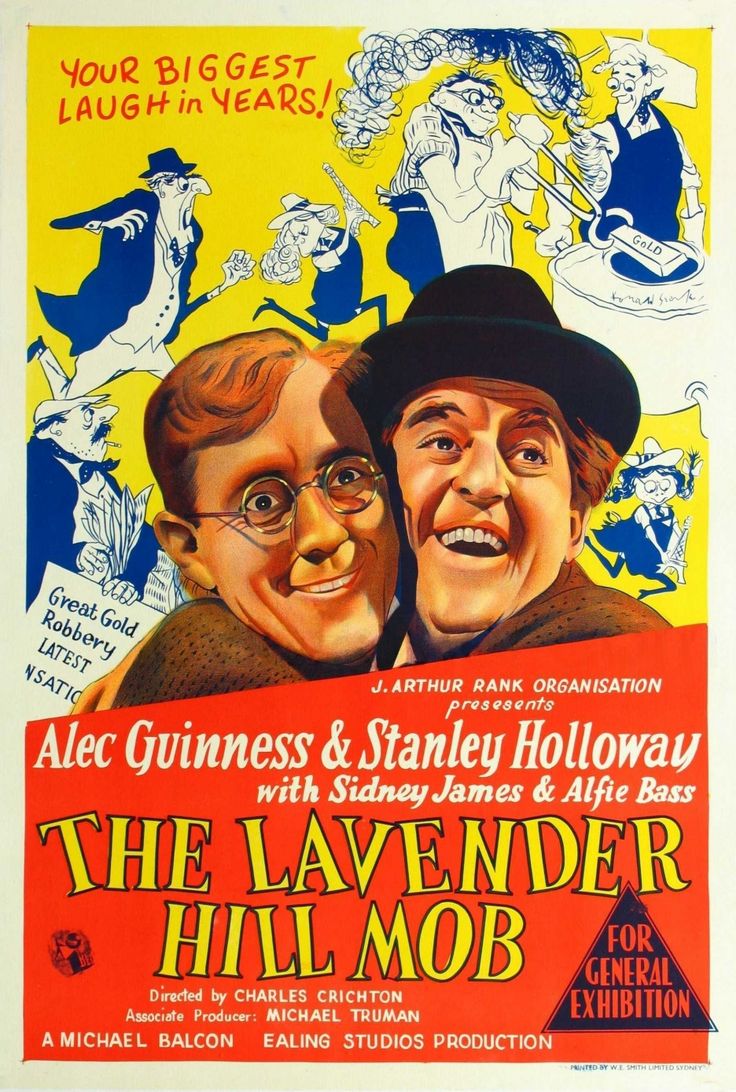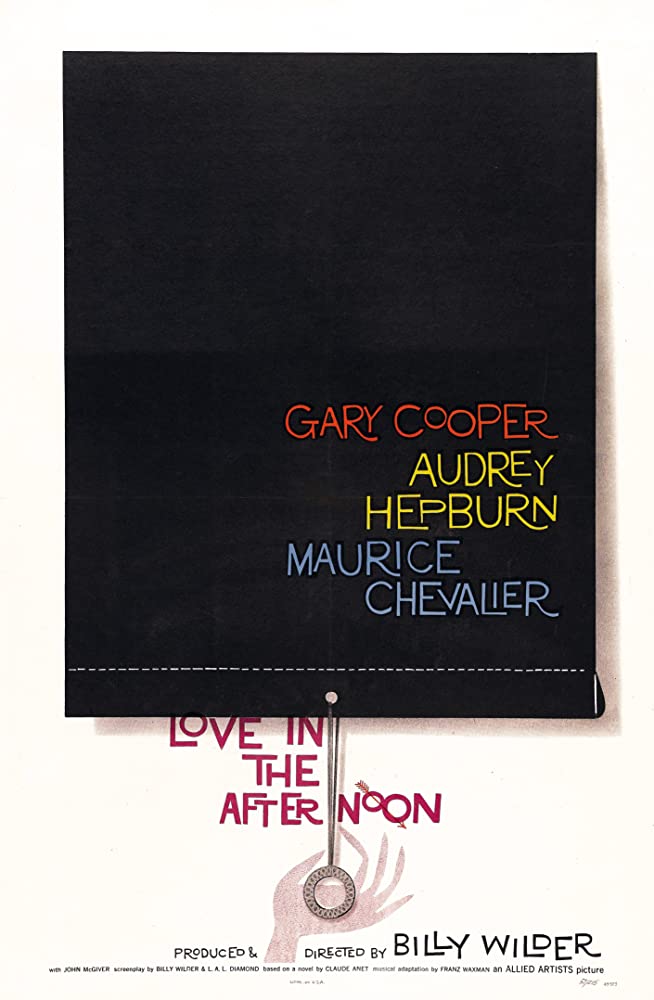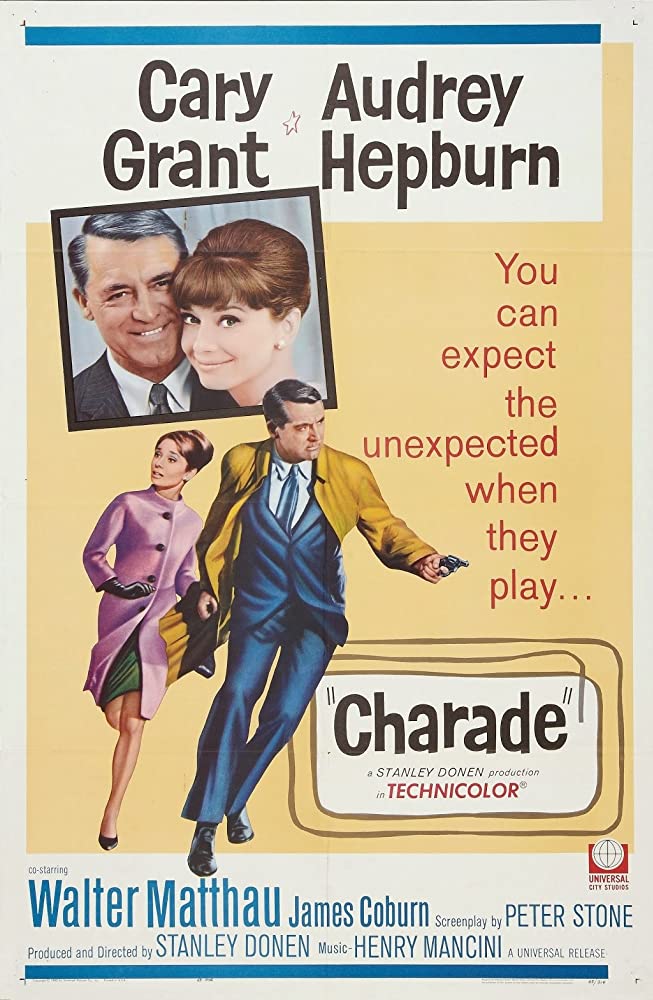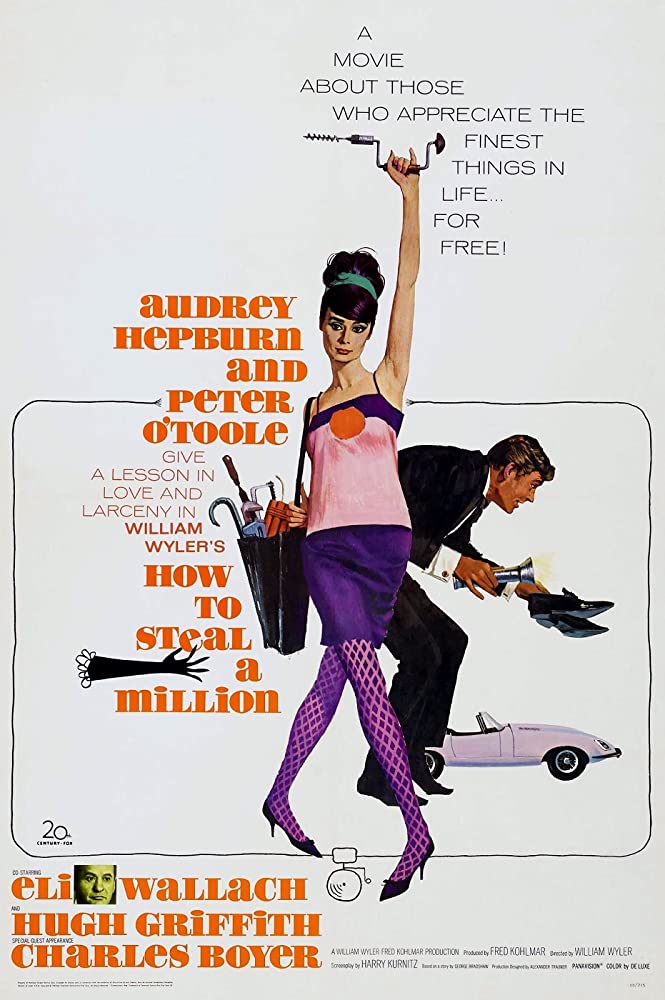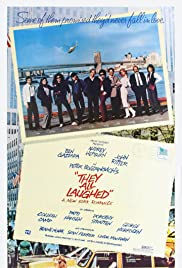Welcome to “The Unexpected Stars of Crime Cinema,” a recurring column in which we examine the careers of movie stars who are not often associated with the crime or mystery genres, despite their starring roles in very many films in those genres.
Join us today as we look at the unlikely crime film legacy of Audrey Hepburn.
___________________________________
For a star whose image is so indelible in pop-culture history, Audrey Hepburn’s filmography is surprisingly lean. She began working in 1949, and by 1953 was cast in a star-making role in Roman Holiday, as a princess playing hooky for a day in Rome, opposite Gregory Peck. She won an Academy Award for this performance, and afterwards, had memorable, leading roles throughout the 50s and 60s, from Sabrina to War and Peace to Breakfast at Tiffany‘s to My Fair Lady. Many of the films in her repertoire, though, are crime movies—and while a great number of them are lighthearted (three of them are on our ranking of the Best Caper films), several of them are very dark. Hepburn retired from acting in 1967, but returned to the screen five times before her death in 1993.
The Lavender Hill Mob (1951)
Then-unknown Audrey Hepburn makes a very small appearance at the start of this comedy, about a mild-mannered bank clerk named Henry Holloway (Alec Guinness) who joins forces with an eccentric souvenir maker (Stanley Holloway) to rob the bank where he’s dutifully worked for twenty years. The movie begins after Holloway has struck gold, in a fancy restaurant in Rio de Janeiro. Hepburn’s character is named Chiquita, and is onscreen for only a few seconds, as one of the friends who says hello to him (and whom he hands some money to), after making off with a stash of gold bouillon. She’s only onscreen for about four seconds, but she really lights it up.
Secret People (1952)
This was Audrey’s biggest film role to date, as a young ballet dancer and the youngest daughter of a man executed by a European dictator. Sisters Maria Brentano (Valentina Cortese) and Nora (Audrey) have absconded to London from their unnamed European country after their father has been taken in. Years later, Nora is moving up in world of classical ballet, and Maria encounters her former sweetheart, Louis (Serge Reggiani), who is by now working on a plot to assassinate the dictator and joins him. But things go very wrong for both sisters when Maria and Louis detonate a bomb and kill an innocent bystander. This is a grim, dark movie but its few moments of brightness are Nora, dancing lightly and beautifully en pointe (Audrey did all her dancing, herself).
Love in the Afternoon (1957)
Billy Wilder’s Love in the Afternoon is technically a romantic comedy, but it loopily pastiches so many elements of noir and detective films that it counts for this list. Audrey Hepburn plays Ariane Chavasse, the daughter of a private detective (Maurice Chevallier) who winds up discovering that one of her father’s clients is going to go shoot the man he’s just learned has been cheating on his wife. Ariane decides to go warn the man, but ends up falling in love with him. (It’s Gary Cooper. He’s fifty-six and she’s twenty-eight, so please excuse me while I go bank my head against the wall.) Winging everything, she puts on a femme-fatale-ish persona and they wind up spending the night together. But (even more) complications ensue when Flannigan (Gary Cooper) hires Ariane’s own father to find out who she is. This movie is… kind of gross (don’t you tell me that Gary Cooper and Hepburn work well together when his face looks like it’s melting off and he can barely crawl to lie next to her on the ground.) But it’s set in Paris, and I guess these kinds of things can happen there.
The Unforgiven (1960)
 Based on the 1957 novel by Alan Le May, John Huston’s The Unforgiven is one of those strange mid-century movies that problematizes racial intolerance while inadvertently playing into it in a much, much worse way. Kind of a reverse of The Searchers, it features Audrey Hepburn as Rachel Zachary, the adopted daughter of a white frontier family. She is accused of actually being a member of the Kiowa tribe—kidnapped from her real family during a raid, many years before. Neighbors in the town turn on the Zacharys after this revelation, and one of the Zachary brothers totally disavows her, but everyone reunites to fight the Kiowa tribe towards the end of the film. So. Notably, Hepburn didn’t want to have much to do with this film after she fell off a horse and broke her back while shooting (which tragically, possibly caused her to miscarry). Production was suspended for a few months, and when she returned, it was only to finish shooting and be done with it.
Based on the 1957 novel by Alan Le May, John Huston’s The Unforgiven is one of those strange mid-century movies that problematizes racial intolerance while inadvertently playing into it in a much, much worse way. Kind of a reverse of The Searchers, it features Audrey Hepburn as Rachel Zachary, the adopted daughter of a white frontier family. She is accused of actually being a member of the Kiowa tribe—kidnapped from her real family during a raid, many years before. Neighbors in the town turn on the Zacharys after this revelation, and one of the Zachary brothers totally disavows her, but everyone reunites to fight the Kiowa tribe towards the end of the film. So. Notably, Hepburn didn’t want to have much to do with this film after she fell off a horse and broke her back while shooting (which tragically, possibly caused her to miscarry). Production was suspended for a few months, and when she returned, it was only to finish shooting and be done with it.
Breakfast at Tiffany’s (1961)
 Based on the novella by Truman Capote but almost entirely rewritten for the screen by George Axelrod (who wrote The Seven Year Itch), Blake Edwards’ Breakfast at Tiffany’s is one of those films which is called a romantic comedy but which is so crime-adjacent that it belongs on this crime list. Possible-lady-of-the-evening/cafe society girl Holly Golightly makes $100 a week for “delivering the weather report” to Sally Tomato (Alan Reed, the voice of Fred Flintstone!) a mobster and drug kingpin doing time at Sing-Sing. But she slowly falls in love with her new neighbor Paul (George Peppard), a struggling writer… who also maybe is a sex worker? Maybe? This is a real “hell is other people” kind of movie; the two of them have to muscle past a sea of other, deadweight human connections in order to arrive at true romance with one another—including Sally Tomato, whose association causes both Holly and Paul to spend a brief stint in jail. A real mixed bag of a movie, it has a gorgeous score by Henry Mancini (including the incomparable “Moon River,” oh my god), but also, you know, Mickey Rooney in yellowface as Holly’s Japanese landlord. Holly Golightly remains Audrey Hepburn’s most famous role, even though it was written for Marilyn Monroe.
Based on the novella by Truman Capote but almost entirely rewritten for the screen by George Axelrod (who wrote The Seven Year Itch), Blake Edwards’ Breakfast at Tiffany’s is one of those films which is called a romantic comedy but which is so crime-adjacent that it belongs on this crime list. Possible-lady-of-the-evening/cafe society girl Holly Golightly makes $100 a week for “delivering the weather report” to Sally Tomato (Alan Reed, the voice of Fred Flintstone!) a mobster and drug kingpin doing time at Sing-Sing. But she slowly falls in love with her new neighbor Paul (George Peppard), a struggling writer… who also maybe is a sex worker? Maybe? This is a real “hell is other people” kind of movie; the two of them have to muscle past a sea of other, deadweight human connections in order to arrive at true romance with one another—including Sally Tomato, whose association causes both Holly and Paul to spend a brief stint in jail. A real mixed bag of a movie, it has a gorgeous score by Henry Mancini (including the incomparable “Moon River,” oh my god), but also, you know, Mickey Rooney in yellowface as Holly’s Japanese landlord. Holly Golightly remains Audrey Hepburn’s most famous role, even though it was written for Marilyn Monroe.
Charade (1963)
Charade isn’t my favorite film on this list, but I adore how cranky Audrey Hepburn is, in it. She plays Regina Lampart, a woman about to divorce her husband when she finds out he’s been murdered. She discovers that he was working with the CIA, but that this was unrelated to his death. When serving in World War II decades before, he had been one of a group of Allied soldiers who secretly stashed a hoard of stolen money. But, turns out, he moved the treasure !He’s probably been bumped off in relation to that, but now that he’s dead, all the men from his old cohort come after Regina, assuming that she knows the actual location of the treasure, and come after her. One of them is James Coborn doing a molasses-thick Texas accent, and another is George Kennedy, a hook-handed assassin who won’t stop yelling. A silver-haired Cary Grant is a friendly stranger she meets who gets wrapped up in the scheme (or is it the other way around?). The pairing of Audrey and Cary doesn’t really work for me (besides their gigantic age difference, I generally don’t really get the appeal of CG in his later years, so take this for what you will). But what DOES work for me a whole lot is the relationship between Audrey Hepburn and Walter Matthau, the stressed out and annoyed-to-be-in-Paris bureaucrat who is helping her with her case. I particularly love the scene where they clandestinely convene in a diner in the early hours of the morning and Matthau just stares really hard at his coffee.
How to Steal a Million (1966)
One of my own favorite films of all time, this delightful caper stars Audrey Hepburn and Peter O’Toole as unlikely partners in crime. Audrey Hepburn is Nicole Bonnet, a French woman who disapproves of her jolly father Charles’s (Hugh Griffith) habit of forging lost masterworks. He’s an flawless imitator of the Great Masters, and makes a pretty penny from selling them, but when he loans a priceless statue forged by his own father to a museum for an exhibition, he finds out that the statue will have to be examined in order for it to be given its required $1 million insurance protection. Knowing that an examination will expose her family’s long history of forgery, Nicole decides to steal it back from the museum, somehow. But, since she has had no interest in a criminal lifestyle until now, she needs some assistance. Fortunately, she’s had a run-in with a tuxedoed cat burglar named Simon Dermott (Peter O’Toole, with the bluest eyes you’ve ever seen) to help. The heist they pull off is eminently clever and charming. And Audrey and Peter have wonderful chemistry—and this is really put to the test when they wind up locked in a broom closet together all night. And though this film doesn’t place our girl in an iconic outfit (as many of her other films do), her wardrobe features a delightful collection of pastel trench coats and patterned tights—as strong a chic aesthetic as she’ll ever have in a film.
Wait Until Dark (1967)
Based on the play by Frederick Knott, this dark and extremely suspenseful film stars Audrey Hepburn as Suzy Hendrix, a recently blinded woman whose husband Sam (Efrem Zimbalist Jr.) winds up bringing a doll full of heroin into their apartment. But several men (Alan Arkin and my mother’s favorite character actor Richard Crenna) are after the drug shipment, and wind up entering her home to search for it. And not only does she have to figure out what’s going on, while she can’t see, but she also has to survive. The first time I saw this movie I was in the seventh grade, and my biggest takeaway at the time was that it’s a really bad idea to accept packages handed to you by strangers in airports.
Bloodline (1979)
Audrey Hepburn made only one film in between Wait Until Dark in 1967 and Bloodline in 1979— Robin and Marian in 1979. In Bloodline, which was based on the novel by Sidney Sheldon, she reunited with director Terence Young (who had directed Wait Until Dark) to play Elizabeth Roffe, the daughter of an assassinated pharmaceutical tycoon. Inheriting her father’s fortune and taking control over the corporation amid familial pressure to take the business public, she realizes that she’s the killer’s next target. Ben Gazzara is her new husband and Gert Fröbe is the detective on the case. But this film packs a litany of stars into its supporting roles, including Omar Sharif, Beatrice Straight, and James Mason.
They All Laughed (1981)
Peter Bogdonavich’s They All Laughed is a silly comedy set in 1980s New York City about private detectives who fall in love with the women they’re spying on, at the behest of their husbands. The main plots are that Ben Gazzara falls in love with Audrey Hepburn and John Ritter falls in love with Dorothy Stratten, but there are a few other romances that get tangled around them, including John Ritter’s girlfriend falling in love with Dorothy Stratten’s boyfriend, who happens to be played by Audrey Hepburn’s own son Sean Hepburn Ferrer. It’s one of those “battle of the sexes” kinds of movies, because the women eventually make marks of the detectives of whom they’re the marks. It doesn’t not work. There are lots of references to the actors’ own relationships and secret love affairs. But the release of the film was overshadowed by the tragic murder of Dorothy Stratten, who had been in a relationship with Bogdonavich. Her estranged husband Paul Snider and former manager had hired a private detective to follow her, and after Dorothy and Bogdonavich moved in together, Snider shot her. She was only twenty years old. Shortly after her death, Bogdonavich attempted to buy the film back from the studio, 20th Century Fox, to attempt to distribute the film himself. He didn’t make his money back, and declared bankruptcy shortly thereafter.
Love Among Thieves (1989)
In Love Among Thieves, which was a TV movie, Audrey Hepburn plays a baroness (who is also a concert pianist) named Caroline DuLac who steals three Fabergé eggs to pay off a ransom on her kidnapped fiancé. She gets on a plane and is met by a man named Mike (Robert Wagner) whom she believes to be one of the kidnappers, until they are pursued by a mysterious man. They must figure out what’s going on, all while avoiding a mercenary named Snider (Jerry Orbach) who has been hired to grab the loot at all costs, and eventually escaping from the Mexican bandits who have nabbed them. It’s kind of like Charade, honestly, though not as good.


